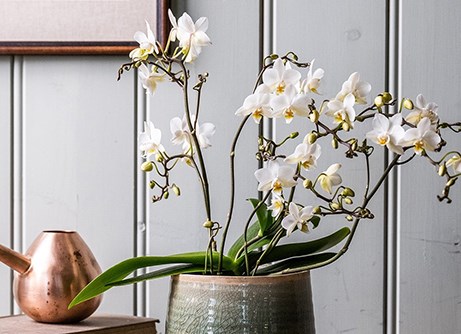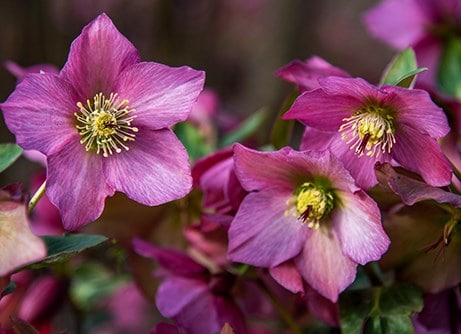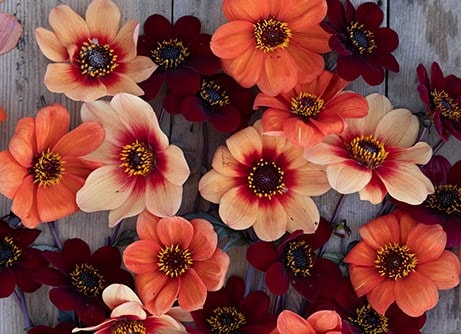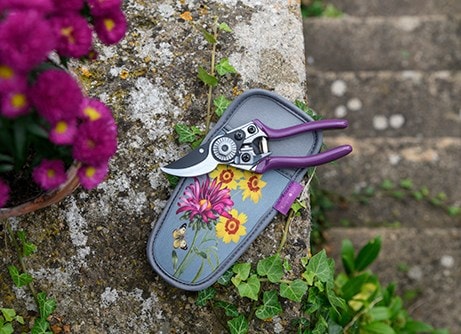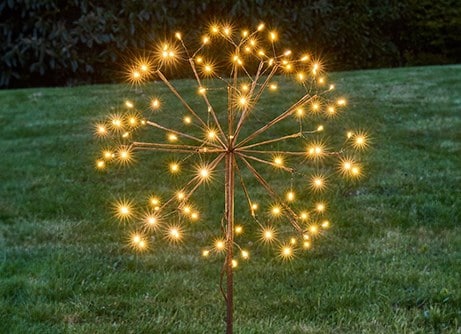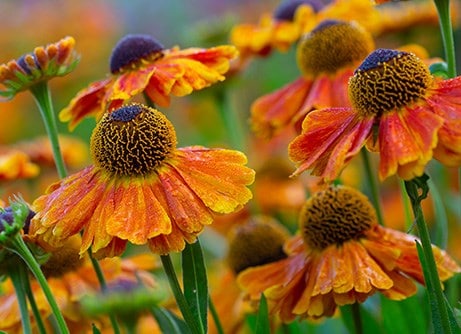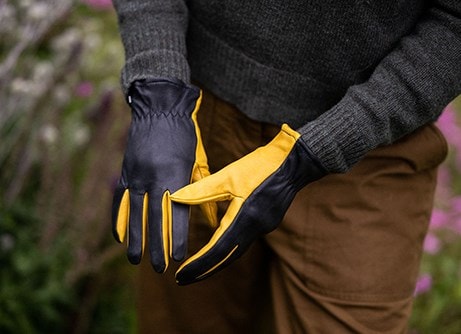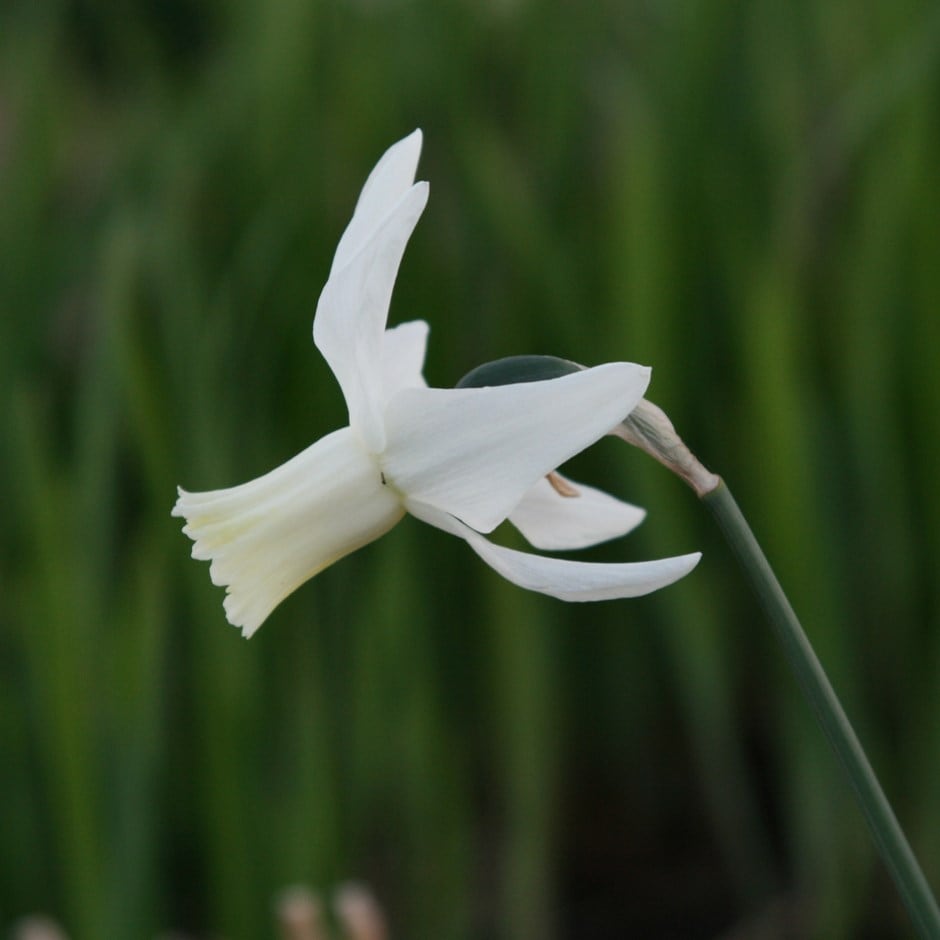
Fantastically fragrant and producing between two and four creamy white flowers on each 35-40cm tall stem, this elegant Triandrus daffodil comes highly recommended. Typically appearing from March to April, the star-shaped flowers of ‘Thalia’ are rich in pollen and nectar, and can last a week or so in the vase once cut. A boon for borders and pots, its relaxed habit enables it to settle seamlessly into naturalised planting schemes, while also being a valuable addition to wildlife-friendly, sensory or cutting gardens.
Introduced over 100 years ago, Narcissus ‘Thalia’ offers an abundance of old world charm, but don’t be fooled by its delicate appearance, as this daffodil is super-easy to grow. Once planted, it will come back year after year in ever-increasing numbers, forming naturalised swathes in borders or lawns.
Ideally Triandrus daffodil bulbs should be given plenty of time to put on strong root growth before the soil temperatures start to dip, so September planting is advised. They can however go in the ground as early as mid to late August (provided they are kept well watered), or as late as October or November.
Plant en-masse in generous swathes through a sun-drenched lawn or border to create breathtaking displays, or use it to underplant deciduous trees and shrubs. If you want to mix it in the border, try planting it with early-flowering perennials such as , Erysimum 'Bowles's Mauve', Aubretia 'Purple Cascade' and Primula elatior.
Alternatively, using just a selection of bulbs, you can create a succession of jewel-like colours that will last from January to July by combining it with , Scilla forbesii 'Violet Beauty', Muscari armeniacum, Ipheion uniflorum 'Wisley Blue', Fritillaria meleagris,Tulipa 'Ronaldo, Allium hollandicum 'Purple Sensation' and Gladiolus communis subsp. byzantinus. Or, for a pristine, all-white display of spring-flowering bulbs, blend ‘Thalia with Anemone blanda 'White Splendour', Fritillaria persica 'Ivory bells', Tulipa 'White Prince' and Fritillaria meleagris var. unicolor subvar. alba.
Introduced over 100 years ago, Narcissus ‘Thalia’ offers an abundance of old world charm, but don’t be fooled by its delicate appearance, as this daffodil is super-easy to grow. Once planted, it will come back year after year in ever-increasing numbers, forming naturalised swathes in borders or lawns.
Triandrus daffodils and when to plant them
Daffodils form a big and diverse group, so for ease of identification, they’re sorted into 13 different divisions. ‘Thalia’ belongs to Division 5 - the Triandrus daffodils, which typically produce two or more relatively small (up to 5cm in diameter) nodding flowers per stem. Commonly referred to as Angel's-tears daffodils, or sometimes Orchid daffodils, the narcissi that fall into this group often have a sweet perfume, while their slightly reflexed perianth segments (the petal-like sections) that surround the corolla (or central cup) give the flowers a windswept appearance.Ideally Triandrus daffodil bulbs should be given plenty of time to put on strong root growth before the soil temperatures start to dip, so September planting is advised. They can however go in the ground as early as mid to late August (provided they are kept well watered), or as late as October or November.
Goes well with pairings
‘Thalia’ looks fabulous in most planting schemes, and as it tolerates partial shade and excess moisture better than most daffodils, it’s also easier to place in the garden.Plant en-masse in generous swathes through a sun-drenched lawn or border to create breathtaking displays, or use it to underplant deciduous trees and shrubs. If you want to mix it in the border, try planting it with early-flowering perennials such as , Erysimum 'Bowles's Mauve', Aubretia 'Purple Cascade' and Primula elatior.
Alternatively, using just a selection of bulbs, you can create a succession of jewel-like colours that will last from January to July by combining it with , Scilla forbesii 'Violet Beauty', Muscari armeniacum, Ipheion uniflorum 'Wisley Blue', Fritillaria meleagris,Tulipa 'Ronaldo, Allium hollandicum 'Purple Sensation' and Gladiolus communis subsp. byzantinus. Or, for a pristine, all-white display of spring-flowering bulbs, blend ‘Thalia with Anemone blanda 'White Splendour', Fritillaria persica 'Ivory bells', Tulipa 'White Prince' and Fritillaria meleagris var. unicolor subvar. alba.
Collections included in
We love the sweet perfume and sheer exuberance that ‘Thalia’ brings to the spring garden, so we’ve woven into several of our pre-designed bulb collections. To create a fresh, bicolored display that’s perfect for pots or border edges, we’ve paired it with Narcissus 'Jack Snipe' and Narcissus 'Sweetness' in our dainty daffodil collection. Also, for a soft and subtle colourway, our Rose water daffodil collection matches ‘Thalia’ with the pure white Narcissus 'Starlight Sensation' and the pink and lemon-flushed Narcissus 'Bell Song'. Our Narcussus 'Snow Fusion' collection offers some of our favourite white-flowering daffodils, including Narcissus 'Ice King', Narcissus 'Misty Glen', Narcissus 'Lieke' - and of course ‘Thalia’. Here the focus is on diversity of shape and form, with subtle hints of green and yellow to add a touch of variation to the colour palette. Finally, our Spring posie bulb collection has a wilder feel about it. Perfect for less structured planting schemes (like cottage gardens or meadows), it contains Fritillaria meleagris (snakes head fritillary) and Muscari latifolium (grape hyacinth) as well as Narcissus ‘Thalia’. This collection is a great choice for the home florist, because if plant it in abundance, you'll have sufficient for your own vases, as well as plenty more to give bouquets for friends and family.How to care for Narcissus Thalia:
Once planted, Narcissus spp. are low-maintenance plants that will generate an abundant display of fresh flowers through February, March and April. Plant them in autumn, in moderately fertile, moist but well-drained soil, where they will receive sun for most (if not all) of the day. The shape and size of daffodil bulbs will vary from species to species, but they should all be planted approximately 10 - 15cm deep, and with their pointy tips uppermost. After planting, water in well and apply a general-purpose fertiliser to encourage the development of strong roots.
In spring, after the flowers have faded, nip off the spent flowerheads, but the stems and leaves should be allowed to die back naturally. In this way, they can then draw their energy back down into the bulb, where it can be stored for the next year's growth.
Daffodils also do extremely well in pots or window boxes filled with a good-quality potting compost. For a one-off seasonal treat, they can be planted shallowly and more densely, and perhaps topped with seasonal bedding such as winter-flowering pansies and primroses After they’ve flowered they can then be re-planted as above in the borders or lawn.
In spring, after the flowers have faded, nip off the spent flowerheads, but the stems and leaves should be allowed to die back naturally. In this way, they can then draw their energy back down into the bulb, where it can be stored for the next year's growth.
Daffodils also do extremely well in pots or window boxes filled with a good-quality potting compost. For a one-off seasonal treat, they can be planted shallowly and more densely, and perhaps topped with seasonal bedding such as winter-flowering pansies and primroses After they’ve flowered they can then be re-planted as above in the borders or lawn.
Flowering period:
- Jan
- Feb
- Mar
- Apr
- May
- Jun
- Jul
- Aug
- Sep
- Oct
- Nov
- Dec
Eventual height:
0.4m
Eventual spread:
0.15m
Position:
Full sun / light shade
Rate of growth:
Average
Soil:
Moderately fertile, moist but well-drained soil, or peat-free general purpose compost
Hardiness:
Fully hardy
-
This bulb dies back after flowering each year and enters a period of rest ahead of regrowth the following season.
-
Humans/Pets: Harmful if eaten; skin irritant
Product options

9cm pot | 3 per pot
£7.99
available to order from winter
Unavailable

2 + 1 FREE 9cm pots
£15.98
£5.33 each
available to order from winter
Unavailable

10 × bulbs
£7.49
£0.75 each
available to order from summer
Unavailable

5 × bulbs | organic
£7.99
£1.60 each
available to order from summer
Unavailable

200 × bulbs
£119.99
£0.60 each
available to order from summer
Unavailable

15 × bulbs | organic
£19.00
£1.27 each
available to order from summer
Unavailable

30 × bulbs
£19.90
£0.66 each
available to order from summer
Unavailable
1
Delivery options (pick your preferred option at checkout)
Standard Delivery£5.99
Goes well with
Exochorda × macrantha 'The Bride'
pearl bush
From £34.99
View options
| 2 litre pot | £34.99 |
|
| 12 litre pot | 1 - 1.2m tall | £89.99 |
|
| 4 litre pot | £49.99 |
|
| 3 × 2 litre pots | £89.99 |
|
View details
Bulb planting auger - long
From £7.99
View options
| set of 3, save £6 | £29.97 |
|
| large | £15.99 |
|
| medium | £11.99 |
|
| small | £7.99 |
|
View details
Bulb planting auger - short
From £6.99
View options
| set of 3, save £5 | £28.97 |
|
| medium | £11.99 |
|
| small | £6.99 |
|
| large | £14.99 |
|
View details

